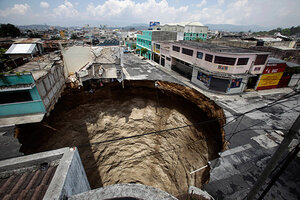What exactly is a sinkhole anyway?
In the aftermath of Tropical Storm Agatha, a 330-foot-deep sinkhole opened up in the middle of Guatemala City. How do sinkholes form in the first place?

Guatemala sinkhole: A giant sinkhole caused by the rains of tropical storm Agatha is seen in Guatemala City June 1. Collapsed roads and highway bridges complicated rescue efforts in Guatemala on Tuesday after Tropical Storm Agatha drenched Central America, burying homes under mud and killing at least 175 people.
Daniel LeClair/REUTERS
In the aftermath of Tropical Storm Agatha, a 330-foot-deep sinkhole opened up in the middle of Guatemala City. Like all sinkholes, the one in Guatamala City formed when a swath of land collapsed, leaving behind a crater-like depression in the ground.
The phenomenon is most common in Florida, Texas, Alabama, Missouri, Kentucky, Tennessee and Pennsylvania, according to the U.S. Geological Survey.
The ground beneath these states is rich in easily dissolved rocks such as limestone, carbonates and salt beds. When groundwater flows through these rocks, it eats away at them, leaving behind subterranean holes and caverns.
IN PICTURES: Guatemala sinkhole
When the roof of one of these caverns collapses, it takes the land above down with it.
Some sinkholes give way gradually and are filled in with dirt or sand from above. Others erode from the surface when easily dissolved rocks are exposed to rain and wind.
The most dangerous sinkholes are those that collapse suddenly. In some cases, the groundwater filling the underground caverns drains away because of drought or because humans divert the flow of groundwater for mining, drinking water or irrigation.
Without the water supporting the roof from below, the land above crumbles. In other cases, the roof of the cavern becomes too weak to support the weight of the soil above it.
These sudden sinkholes can swallow cars, houses and even drain entire lakes without warning.
In September 1999, Lake Jackson near Tallahassee, Fla., which measured more than 6 square miles (16 square kilometers), disappeared almost completely, drained from below by a 50-foot-deep (15-meter-deep) sinkhole.
But don't worry, it'll be back: According to the Florida Geological Survey, the lake drains and refills every 25 years.
